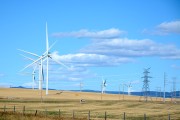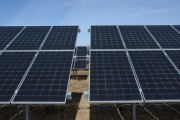As many commentators have acknowledged, President Obama’s new Clean Power Plan is the most significant environmental action taken by the United States in at least two decades. It puts the U.S. on a path that could see the country reach its 2020 international climate commitments — unlike Canada.
Obama’s actions pose a major challenge for our international reputation and competitiveness: while the U.S. is now taking action on its largest source of carbon pollution — coal-fired electricity — we have yet to act on our biggest emissions problem going forward, namely the oilsands. Still, some commentators seek to defend the oilsands by pointing out that coal is the “U.S.’s much dirtier enemy”.
But, before we throw stones, let’s not forget that Alberta also has a big coal problem — proportionally bigger than the U.S.
Alberta’s electricity grid is proportionally much more reliant on coal, at 63.7 per cent, than the U.S. average, which is 39.1 per cent. Total coal generation in the U.S. has fallen by nearly a quarter from 2007 to 2013. Meanwhile, with two old Alberta coal units returning to service in late 2013, Alberta now has more coal capacity than ever before. Over the next few years, coal-fired generation is likely to rise to the highest point in Alberta history.
The result? Alberta’s electricity emits 60 per cent more carbon for every kWh than the U.S. average.
Alberta is one of very few jurisdictions in North America that has not implemented policies to encourage deployment of clean, renewable electricity.
The U.S. is targeting electricity emissions in 2030 that are 30 per cent below 2005 levels and early signals suggest they will likely go even further. While federal regulations that limit coal units to 50 years will bring Alberta’s electricity emissions to a low point of 23 per cent below 2005 levels in 2030, industry’s own analysis shows that provincial electricity emissions will then do a 180 — increasing to the highest point in the province’s history by mid-century.
It’s one thing to debate how many reductions are necessary to pull Alberta’s environmental reputation out of the pits, but an absolute increase in carbon pollution out to 2050 is a clear policy failure.
Part of the problem is that Alberta is one of very few jurisdictions in North America that has not implemented policies to encourage deployment of clean, renewable electricity.
Last month, the Pembina Institute along with Clean Energy Canada released new modelling in the report Power to Change, which shows that under today’s policy approach, renewable energy’s share of total electricity in Alberta will rise from a mere 10 per cent today to only 12 per over the next two decades.
Numbers from the Alberta Electric System Operator (AESO) in its 2014 Long-term Outlook are identical: 88 per cent of our electricity will still come from fossil fuels in 20 years, mostly natural gas. Renewables are expected to grow, but at a slower rate than they have in the past 10 years. At a time when we can be cost effectively ramping up renewables to avoid locking into increasing carbon emissions with risky reliance on natural gas, renewables are barely expected to increase their share of total generation.
Fortunately, our analysis also shows that Alberta has the ability to take a clear lead on reducing electricity emissions through renewable energy and energy efficiency, if it decides to. Instead of locking the province into a very heavy reliance on natural gas, we examined two realistic scenarios that would diversify our energy sources.
In all cases, it’s clear that natural gas will still play a role, but these alternative scenarios would facilitate a much broader diversity of energy sources, preventing fossil fuels from monopolizing the grid. While natural gas generation is proving very profitable to the power companies, our alternative scenarios would be more cost effective for consumers in the long run.
Wind energy’s costs, for example, are already lower than new coal and on par with new natural gas generation — even if natural gas prices stay relatively low for 20 years. And while consumers could wind up paying extra for unexpected natural gas price increases, renewables like wind and solar have no fuel cost risks.
While natural gas generation is proving very profitable to the power companies, our alternative scenarios would be more cost effective for consumers in the long run.
What’s more, these alternative scenarios would also see electricity-sector carbon pollution dropping to 47 per cent and 70 per cent below 2005 levels in 2030. This opportunity can help make up for the difficulty that industry has had finding emissions reductions in other high-emitting sectors, like Alberta’s oilsands.
But don’t just take my word for it. Once again, the AESO also conjures alternative scenarios that could see lower total energy demand and much larger contributions from renewable energy.
Alberta has long promised, but so far failed to deliver a renewable energy policy framework. Our research shows that effective renewable energy policy would help protect consumers and reduce pollution.
Without the necessary provincial policy to grow renewables though, the bulk of new capacity additions will be natural gas generation, which is much more profitable for power companies. It is, however, not likely to be the lowest-cost option for Albertans, nor will it help demonstrate climate leadership to international markets.





